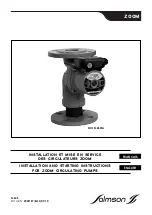
ENGLISH
12
The motor does not start but makes noise.
−
Ensure that the mains voltage corresponds
to the voltage on the data plate.
−
Check that the connections have been
made correctly.
Correct any errors.
−
Check that all the phases are present on the
terminal board.
If not, restore the missing phase.
−
The shaft is blocked. Look for possible
obstructions in the pump or motor.
Remove any obstructions.
−
Capacitor short-circuiting or broken.
Change the capacitor.
The motor turns with difficulty.
−
Check the supply voltage which may be
insufficient.
−
Check whether any moving parts are
scraping against fixed parts.
Eliminate the cause of the scraping.
−
Check the state of the bearings.
Change any worn bearings.
The (external) motor protection trips immediately
after starting.
−
Check that all the phases are present on the
terminal board (on three-phase models).
If not, restore the missing phase.
−
Look for possible open or dirty contacts in
the protection.
Change or clean the component concerned.
−
Look for possible faulty insulation of the
motor, checking the phase resistance and
insulation to earth.
Change the motor casing with the stator or reset
any cables discharging to earth.
The motor protection trips too frequently.
−
Ensure that the environment temperature is
not too high.
Provide suitable ventilation in the environment
where the pump is installed.
−
Check the calibration of the protection.
Calibrate at a current value suitable for the motor
absorption at full load.
−
Check the motor rotation speed.
Consult the motor data plate.
−
Check the state of the bearings.
Change any worn bearings.
The pump vibrates and operates noisily.
−
Check that the pump and/or the pipes are
firmly anchored.
Fasten any loose parts.
−
There is cavitation in the pump.
Increase the system pressure, keeping within the
allowed limits.
−
The pump is running above its plate
characteristics.
Reduce the flow rate.
−
Ensure that the mains voltage corresponds
to the voltage on the data plate.
Summary of Contents for 1CM-G 80-650
Page 3: ......
Page 35: ...30 4 2 3 DIN 4181 1 2 3 4 5 5 5 1 5 2 A 73 LpA 85 A 5 3 6 40 C B IP55 C 8 7 74 5 1 2 4 3...
Page 36: ...31 B 73 D 8 E F 5 G 9 30 5 5 20 30 7 5 60 5 10 9 1 H 10 IP55...
Page 37: ...32 10 1 4 Fig 4 11...
Page 38: ...33...
Page 62: ...57 BIZ y A Be A 74 73 B D pcK A E F G LBiB KRG...
Page 63: ...58 30 20 30 5 5 HP 5 10 60HP 7 5 H Z e X OK A ZiU 1 9 IP55 OR 1 10 4 4...
Page 64: ...59...
Page 66: ...61 4 2 DIN 4181 1 2 3 4 5 5 5 1 5 2 73 85 Db A 5 3 6 400 B IP55 C 8 7 3 D 3 5 1 2 4 3...
Page 67: ...62 8 E 3 F 5 G 9 1 30 3 5 5 HP 20 30 3 7 5 60 HP 5 10 9 1 H 10 10 1 4 4 11 3...
Page 68: ...63...
Page 70: ...65 4 2 1 2 3 4 5 5 5 1 5 2 A 73 85 5 3 6 40 IP 55 7 74 B 5 1 2 4 3...
Page 71: ...66 8 5 9 30 5 5Hp 20 30 7 5 60 5 10 9 1 H 10 10 1 4...
Page 72: ...67 11...
Page 74: ...69 4 2 3 DIN 4181 1 2 3 4 5 5 5 1 5 2 A 73 LpA 85 A 5 3 6 40 C B IP55 C 7 74 B 73 5 1 2 4 3...
Page 75: ...70 D 8 E F 5 G 9 30 5 5 20 30 7 5 60 5 10 9 1 H 10 IP55...
Page 76: ...71 10 1 4 4 11...
Page 77: ...72...
















































